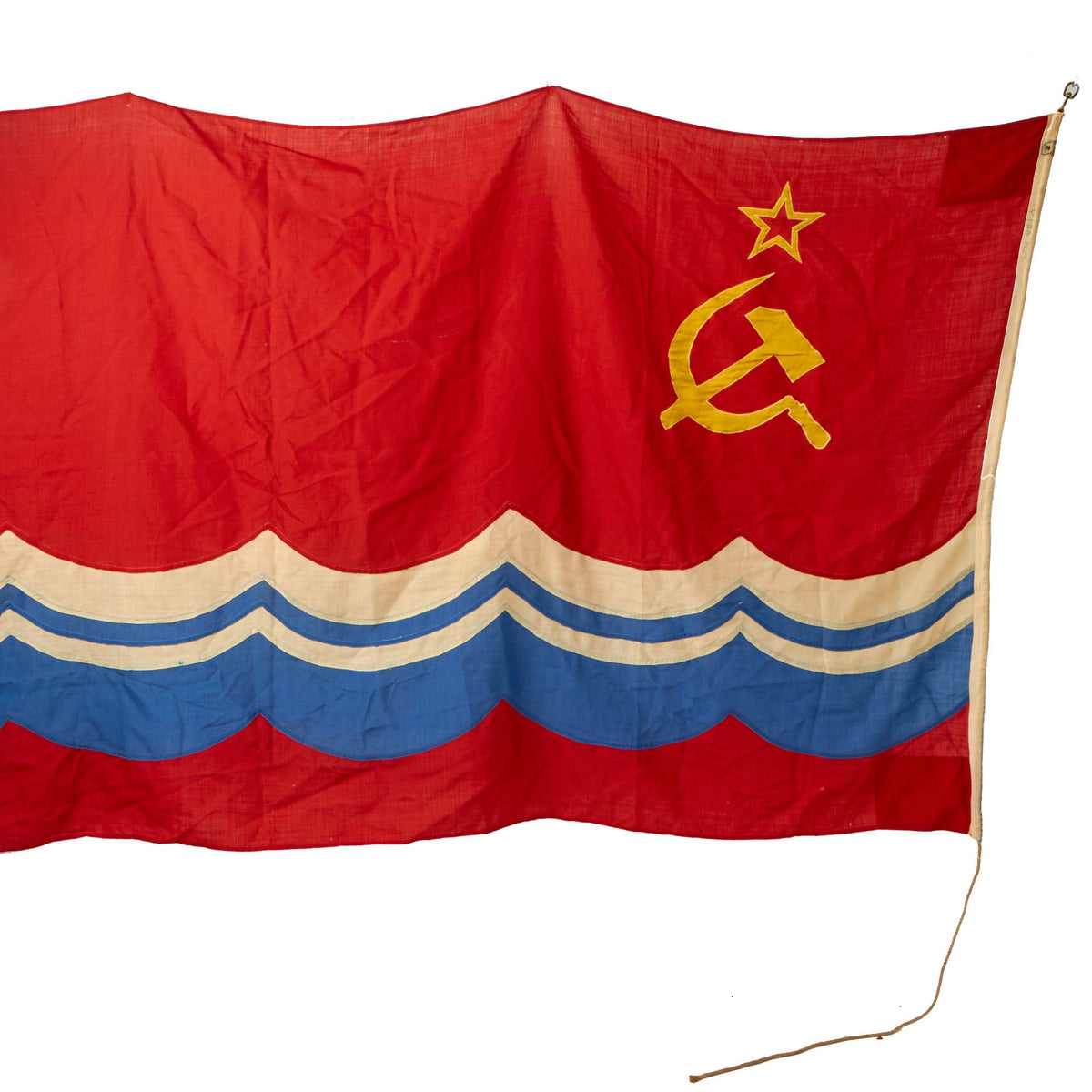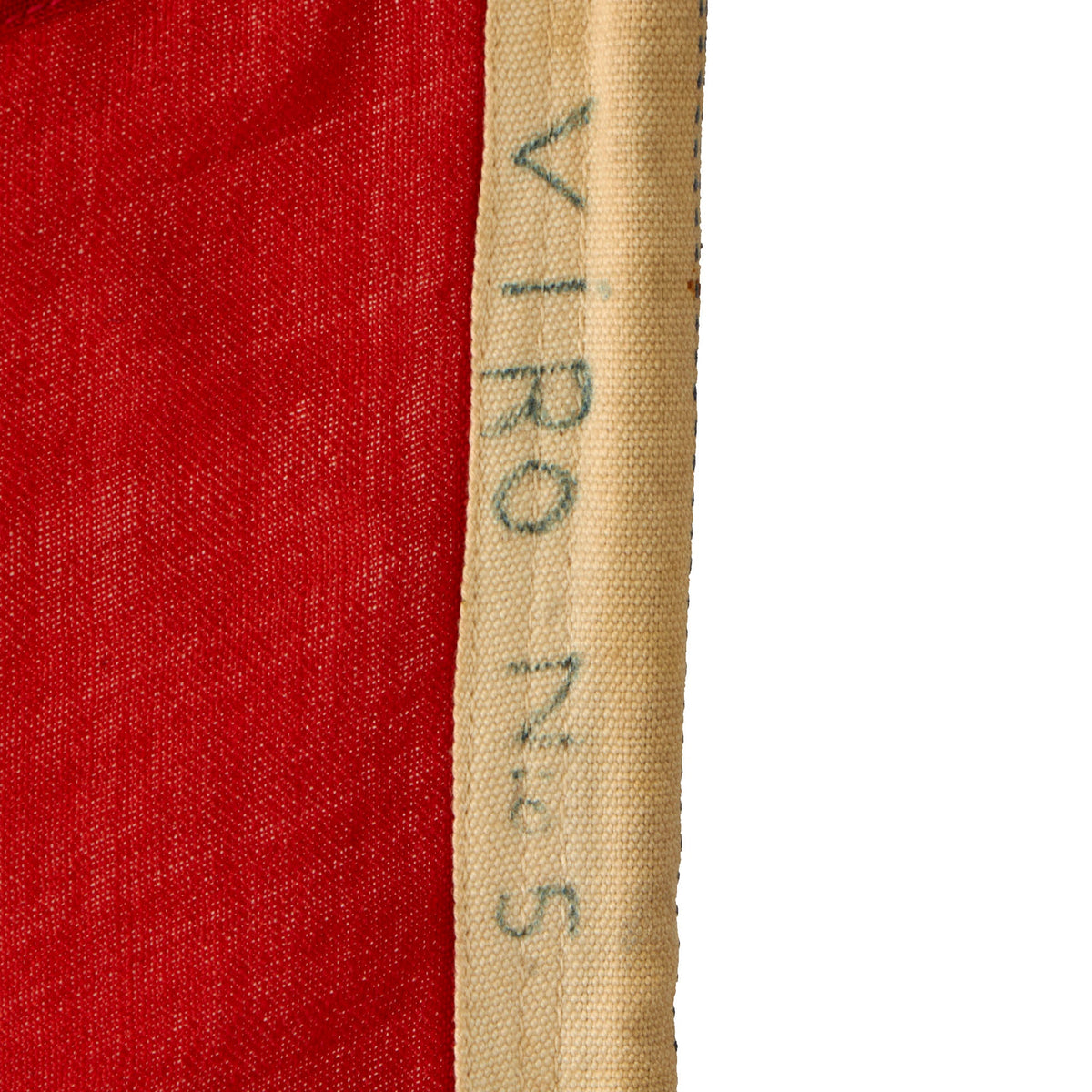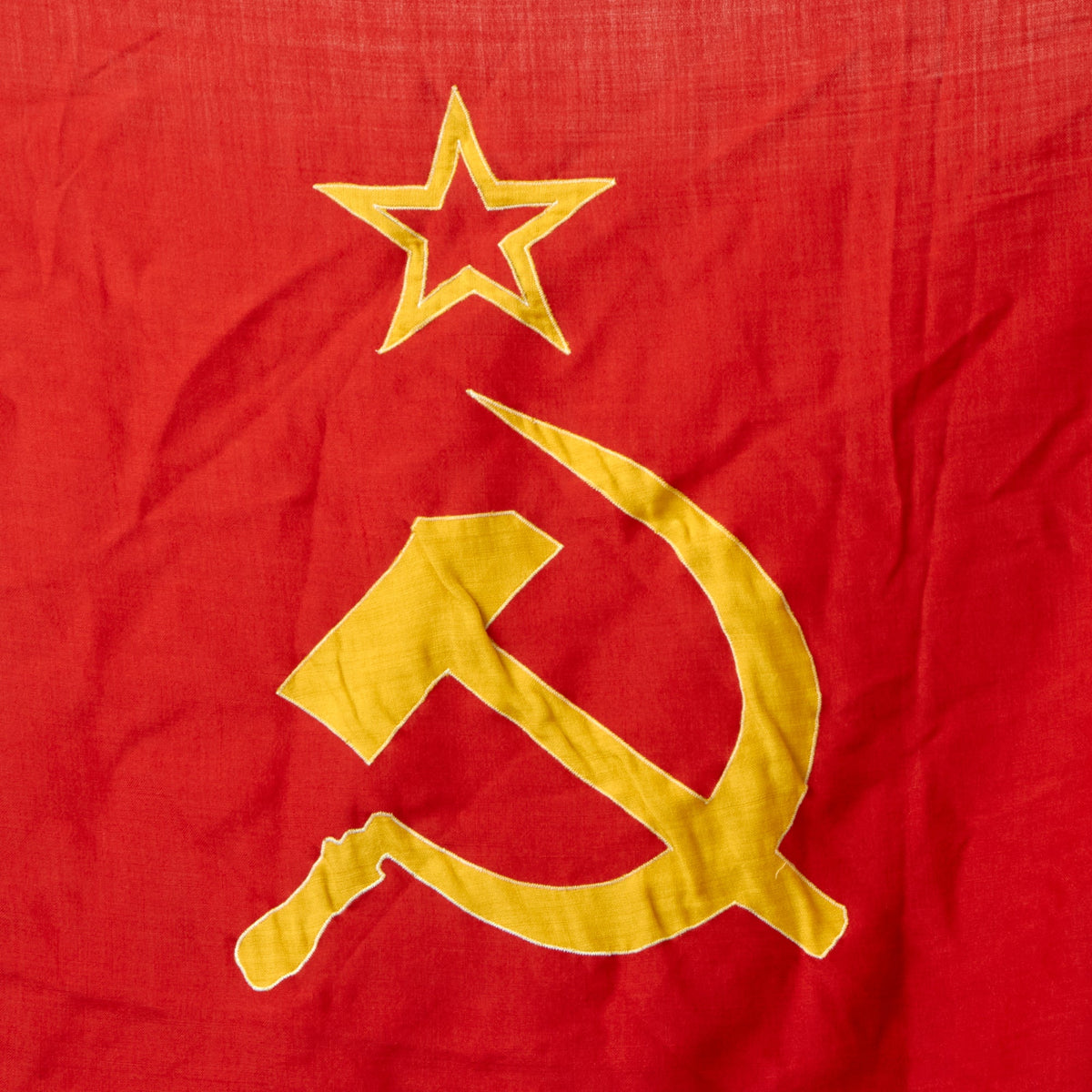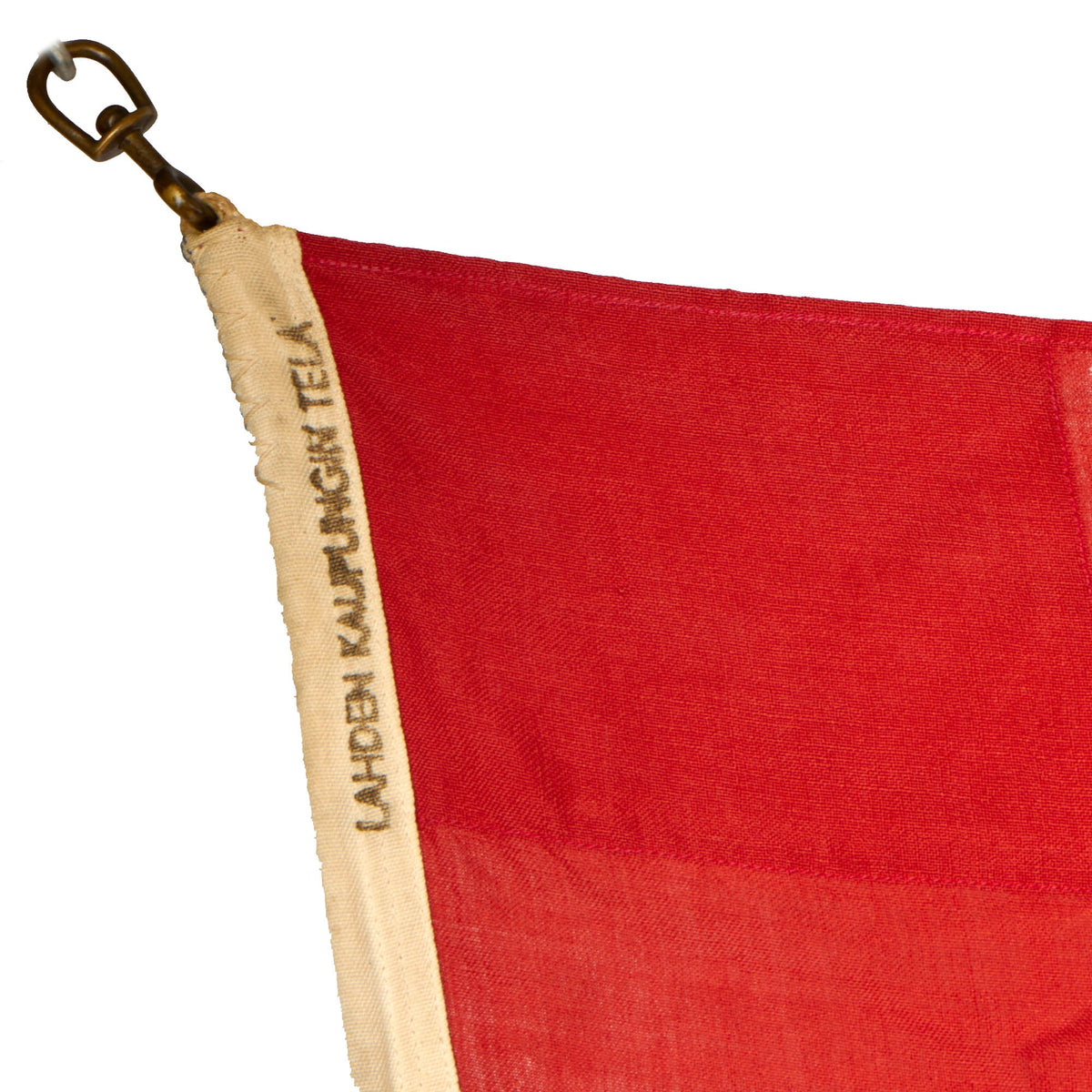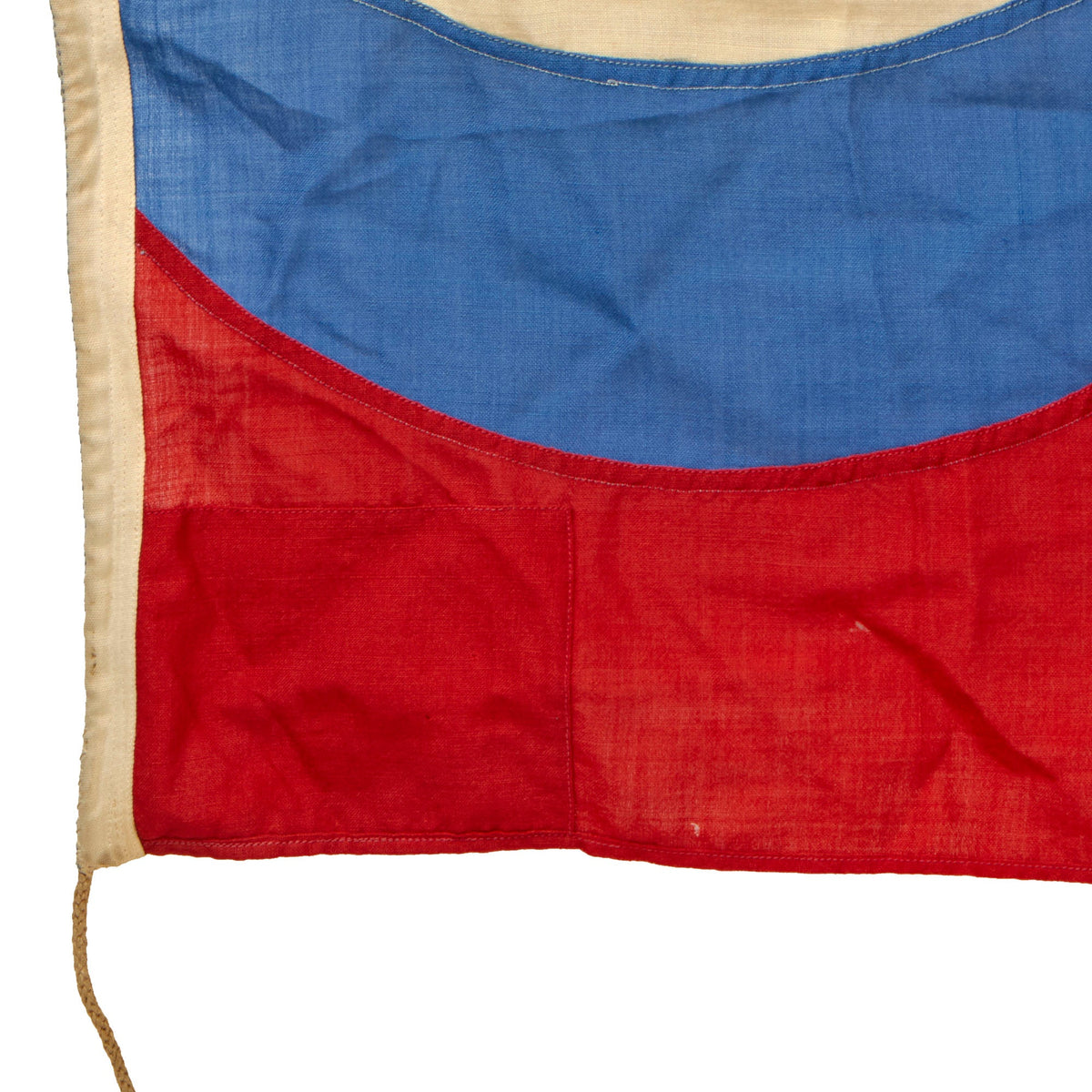Original Estonian Soviet Socialist Republic Cold War Era Flag with Halyard – 52″ x 108″ Original Items
$ 150,00 $ 60,00
Original Item. Only One Available. This is a very flag of the Estonian Soviet Socialist Republic in a very large size, roughly 52″ x 108”. During the period of foreign rule in 1940–1991, the Estonian diaspora and diplomatic service around the world continued to use the national flag of Estonia, whereas the use of the national tricolor and its blue, black and white color combination was banned and punishable by law in the Soviet Union until 1988.
The flag is red with the Soviet “Sickle and Hammer” under a star in the top left, with blue and white waves going across the flag a bit above the bottom. The flag has a halyard and hook at the other end with a maker’s tag for KARHU and the words VIRO NO. 5 are written next to the tag. On the opposite side is the stamp LAHDEN KALPLINGIN TELA. These are certainly Estonian maker’s-marks. The flag is very well stitched and has very few flaws minus some tiny holes and staining. This flag likely dates to the 1950s-1970s, being adopted in 1953 and relinquished in 1990.
This is a great Estonian Soviet Socialist Republic flag that will become the centerpiece of any Cold War Collection. Comes ready for further research and display.
The Estonian Soviet Socialist Republic (Estonian SSR), Soviet Estonia, or simply Estonia, was a union republic of the Soviet Union (USSR), covering the occupied and annexed territory of Estonia in 1940–1941 and 1944–1991. The Estonian SSR was nominally established to replace the until then independent Republic of Estonia on 21 July 1940, a month after the 16–17 June 1940 Soviet military invasion and occupation of the country during World War II. After the installation of a Stalinist government which, backed by the occupying Soviet Red Army, declared Estonia a Soviet constituency, the Estonian SSR was subsequently incorporated into the Soviet Union as a “union republic” on 6 August 1940. Estonia was occupied by NSDAP Germany in 1941, and administered as a part of Reichskommissariat Ostland until it was reconquered by the USSR in 1944.
After the Soviet invasion and occupation of Estonia in June 1940, the country was annexed to, and became an administrative subdivision of, the USSR under the name “Estonian Soviet Socialist Republic” in August 1940. After 31 October 1940, a Soviet Union flag with Latin script ENSV replacing the star above the hammer and sickle, was officially used by the Soviet authorities in the Estonian SSR. On 6 February 1953, a new version of the flag was adopted. It too followed the style of the flag of the Soviet Union, with six spiky blue and white wavy stripes added to the bottom.
During the period of foreign rule in 1940–1991, the Estonian diaspora and diplomatic service around the world continued to use the national flag of Estonia, whereas the use of the national tricolour and its blue, black and white colour combination was banned and punishable by law in the Soviet Union until 1988.
On 20 October 1988, the usage of the blue-black-white flag was officially allowed again by Estonian authorities. On the evening of 23 February 1989 the Soviet flag was taken down permanently from the tower of Pikk Hermann of the Toompea Castle. It was replaced with the national blue-black-white flag on the next morning, 24 February, upon the 70th anniversary of the Estonian Declaration of Independence.
With the Act on symbols of Estonia, passed on 8 May 1990, a year before Estonia regained full independence in 1991, the use of the Estonian SSR flag and emblem as state symbols was officially discontinued.
Fast Shipping with Professional Packaging
Thanks to our longstanding association with UPS FedEx DHL, and other major international carriers, we are able to provide a range of shipping options. Our warehouse staff is expertly trained and will wrap your products according to our exact and precise specifications. Prior to shipping, your goods will be thoroughly examined and securely secured. We ship to thousands clients each day across multiple countries. This shows how we're dedicated to be the largest retailer on the internet. Warehouses and distribution centres can be located throughout Europe as well as the USA.
Note: Orders with more than one item will be assigned a processing date depending on the item.
Before shipping before shipping, we'll conduct a thorough inspection of the items you have ordered. Today, the majority of orders will be delivered within 48 hours. The delivery time will be between 3-7 days.
Returns
The stock is dynamic and we cannot completely manage it because multiple stakeholders are involved, including our factory and warehouse. So the actual stock may alter at any time. It's possible that you may not receive your order once the order has been made.
Our policy is valid for a period of 30 days. If you don't receive the product within 30 days, we are not able to issue a refund or an exchange.
You can only return an item if it is unused and in the same state as the day you received it. You must have the item in its original packaging.
Related products
Uncategorized
Angolan Rebel 1970s era 60mm Inert Display Mortar from Angolan Civil War Original Items
Uncategorized
Uncategorized
Band of Brothers ORIGINAL GERMAN WWII Le. F.H. 18 10.5cm ARTILLERY PIECE Original Items
Uncategorized
Uncategorized
Armoured Fighting Vehicles of the World: AFVs of World War One (Hardcover Book) New Made Items
Uncategorized
Australian WWII Owen MK1 Machine Carbine SMG Custom Fabricated Replica with Sling Original Items
Uncategorized
Uncategorized
Armored Burgonet Helmet & Polearm from Scottish Castle Leith Hall Circa 1700 Original Items
Uncategorized
Uncategorized
Uncategorized
Uncategorized
Uncategorized
Uncategorized
Uncategorized
Uncategorized
Uncategorized

